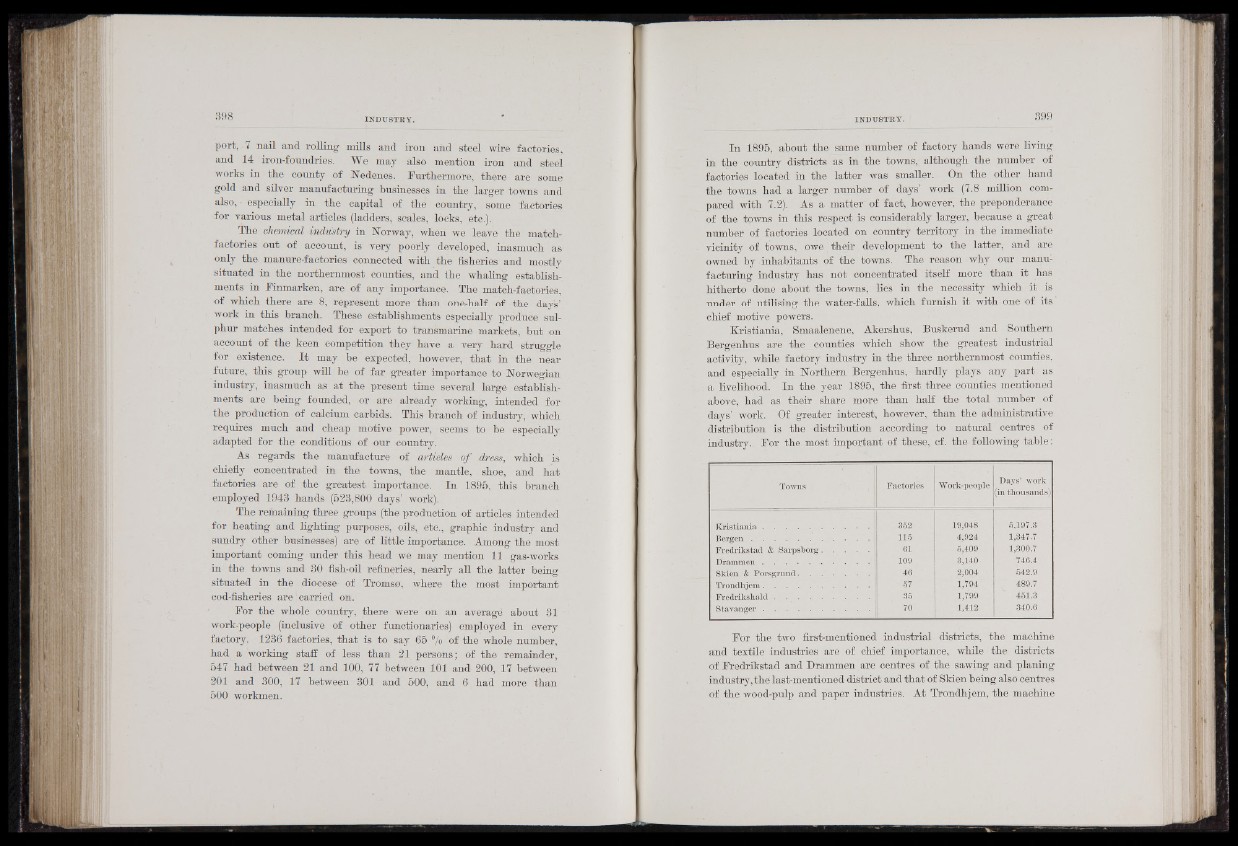
port, 7 nail and rolling mills and iron and steel wire factories,
and 14 iron-foundries. We may also mention iron and steel
works in the county of Nedenes. Furthermore, there are some
gold and silver manufacturing businesses in the larger towns and
also, - especially in the capital of thé country, some factories
for various metal articles (ladders, scales, locks, etc.).
The chemical industry in Norway, when we leave the match-
factories out of account, is very poorly developed, inasmuch as
only the. manure-factories connected with the fisheries and mostly
situated in the northernmost counties, and the whaling establishments
in Finmarken, are of any importance. The match-factories,
of which there are 8, represent more than one-half of the day's’
work in this branch. These establishments especially produce sulphur
matches intended for export to transmarine markets, but on
account of the keen competition they have a very hard struggle
for existence. I t may be expected, however, that in the near
future, this group will be of far greater importance to Norwegian
industry, inasmuch as at the present time several large establishments
are being founded, or are already working, intended for
the production of calcium carbids. This branch of industry, which
requires much and cheap motive power, seems to be especially
adapted for the conditions of our country.
As regards the manufacture of articles of dress, which is
chiefly concentrated in the towns, the mantle, shoe, and hat
factories are of the greatest importance. In 1895, this branch
employed 1943 hands (523,800 days’ work).
The remaining three groups (the production of articles intended
for heating and lighting purposes, oils, etc., graphic industry and
sundry other businesses) are of little importance. Among the most
important coming under this head we may mention 11 gas-works
in the towns and 30 fish-oil refineries, nearly all the latter being
situated in the diocese of Tromso, where the most important
cod-fisheries are carried on.
For the whole country, there were on an average about 31
work-people (inclusive of other functionaries) employed in every
factory. 1236 factories, that is to say 65 °/o of the whole number,
had a working staff of less than 21 persons; of the remainder,
547 had between 21 and 100, 77 between 101 and 200, 17 between
201 and 300, 17 between 301 and 500, and 6 had more than
500 workmen.
In 1895, about the same number of factory hands were living
in the country districts as in the towns, although the number of
factories located in the latter was smaller. On the other hand
the towns had a larger number of days’ work (7.8 million compared
with 7.2). As a matter of fact, however, the preponderance
of the towns in this respect is considerably larger, because a great
number of factories located on country territory in the immediate
vicinity of towns, owe their development to the latter, and are
owned by inhabitants of the towns. The reason why our manufacturing
industry has not concentrated itself more than it has
hitherto done about the towns, lies in the necessity which it is
under of utilising the water-falls, which furnish it with one of its
chief motive powers.
Kristiania, Smaalenene, Akershus, Buskerud and Southern
Bergehhus are the_ counties which show the greatest industrial
activity, while factory industry in the three northernmost counties,
and especially in Northern Bergenhus, hardly plays any part as
a livelihood. In the year 1895, the first three counties mentioned
above, had as their share more than half the total number of
days’ work. Of greater interest, however, than the administrative
distribution is the distribution according to natural centres of
industry. For the most important of these, cf. the following table:
Towns Factories Work-people Days’ work
[in thousands)
Kristiania . . . . . . . . fl 362 19,048 5,197.3
Bergen • • ! • • • • ■ • •■lr&§lis . 116 4,924 1,347.7
Fredrikstad & Sarpsborg. I . BUS 61 5,409 1,300.7
Drammen ................................................ 109 3,140 746.4
Skien & Porsgrund............................... 46 2,004 542.9
Trondhjem............................................... 67 1,794 489.7
Fredrikshald . . . ., » • .■ ,:.r Hb I 36 1,799 451.3
S ta v a n g e r............................... ; 70 1,412 340.6
For the two first-mentioned industrial districts, the machine
and textile industries are of chief importance, while the districts
of Fredrikstad and Drammen are centres of the sawing and planing
industry, the last-mentioned district and that of Skien being also centres
of the wood-pulp and paper industries. At Trondhjem, the machine